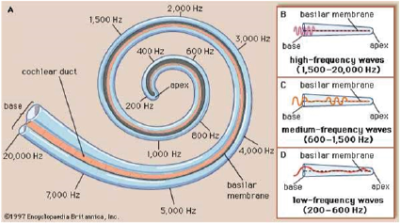
How frequence is detected by the ear/How the ear distinguishes the frequencies of sound
The analysis of sound frequencies by the basilar membrane.
The fibres of the basilar membrane become progressively wider and more flexible from the base of the cochlea to the apex. As a result, each area of the basilar membrane vibrates preferentially to a particular sound frequency.
The higher the frequency of the sound imposed, the shorter the distance the waves travel.
Thus, atone of a given frequency causes stimulation to reach a peak at a certain place on the basilar membrane. The region that vibrates most vigorously stimulates the greatest number of hair cells in that area of the organ of Corti, and these hair cells send the most nerve impulses to the auditory nerve and the brain The brain recognizes the place on the basilar membrane, and thus the pitch of the tone, by the particular group of nerve fibres activated.
- High-frequency sound waves cause maximum vibration of the area of the basilar membrane nearest to the base of the cochlea.
- medium-frequency waves affect the centre of the membrane;
- low-frequency waves preferentially stimulate the apex of the basilar membrane.
The locations of cochlear frequencies along the basilar membrane shown are a composite drawn from different sources. below

Please find free downloadable notes, exams and marking guides of agriculture, biology, and chemistry from digitalteachers.co.ug website.
Dr. Bbosa Science
